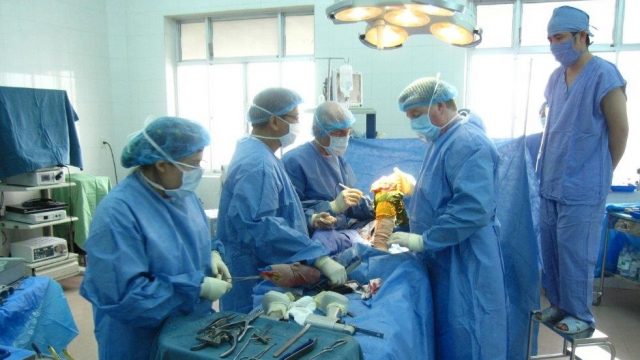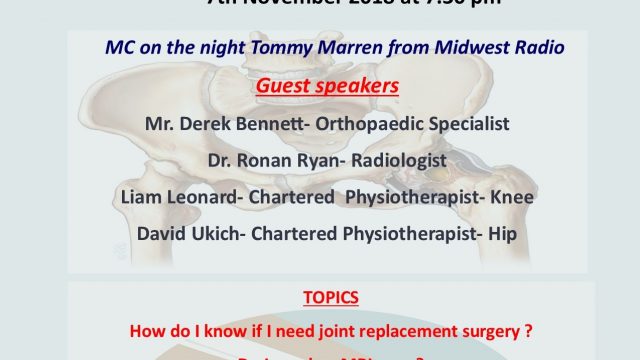standard-title
Physiotherapy FAQ’s
FAQ’s Physiotherapy post hip and knee replacement.
How much physiotherapy do I need?
-
Surprisingly little. The best time to have physiotherapy is before your surgery. This allows you to become familiar with the post-operative exercises before you enter the hospital. During pre-operative physiotherapy you will also be taught basics like walking with crutches and climbing stairs.
-
During your 2-4 day inpatient stay the ward physiotherapist will help get back you on your feet walking again.
Why is it so important to regain full knee straightening after TKR surgery?
-
This is the most important range of motion to regain. To walk efficiently you need full knee straightening. If you walk on a bent knee it is exponentially more taxing on your muscles. You will tire much faster. Prioritize knee straightening exercises.
Will one leg be longer than the other?
-
This is a very common concern. The answer is no. You may have the perception of a longer leg for a few weeks/months but this will resolve with time. By the time you need a knee or hip replacement the space in your joint has reduced as the cartilage has worn. When you get a replacement joint it restores the natural space in the joint. This can give you the perception of it feeling longer but in essence it is restoring you back to level. The body just needs to recalibrate.
What’s the best exercise I can do after my surgery?
-
The best exercise to re-train your hip and knee muscles is walking.
How much walking should I do?
-
As a guideline we suggest to do 20 minutes of continuous walking 3 times a day. In the beginning you may tire earlier but you can build this up over a couple of weeks. By your six week review you should have reached 20 mins walking 3 times a day.
How long will I have to use crutches?
-
Two crutches for 6 weeks then weaning down to one crutch for 1-2 weeks. After that you may walk independently. Do not use a walking stick.
When I go down to one crutch which side should I keep the crutch on?
-
Great question. You should keep the crutch on the opposite side of the joint you had replaced. For example, if you had your right hip replaced keep the crutch on the left side. If you had your left knee replaced you keep the crutch on the right side. This stops you from leaning over to one side keeping your gait symmetrical
I’m a little nervous to wean away from one crutch. What should I do?
-
Our advice is when you first start to walk take as many steps as you can before you start to feel tired or a little shaky. Then use the crutch thereafter. It’s a good idea to count your steps initially. For example when you first start to walk without the crutch take 20-30 steps then use the crutch. When you can reach 1000 steps you can throw away the crutch.
Is cycling better than walking?
-
Walking is a much better exercise to do than cycling. It is more functional to the demands of daily life. If you want to improve your endurance for walking, the best exercise to practice is walking not cycling. Practice makes perfect.
I feel a little tight and sore in my muscles after the surgery. Is this normal?
-
Yes of course, this is normal. You will be given a prescription of medication to take after the surgery to minimize discomfort and allow you to get moving again. You will not do any damage by walking. Keep moving. Do not let this stop you from exercising. All artificial joints love movement.
Is there anything I shouldn’t do after total hip replacement?
-
Yes. For the first 12 weeks after the surgery high bending of the hip beyond 90 degrees is not allowed.
-
You should avoid twisting the hip when you want to turn around. Lift your feet instead and turn with care.
-
You should also avoid crossing your legs beyond mid-line.
These restrictions are in place to allow the ligaments to heal around the new implant. After 12 weeks there are no restrictions on your movements or activities.
Latest News on Your Doctor's Blog
Loading…
In April 2016 the first International Chapter of Operation Walk joined Operation Walk Chicago on a mission in Hanoi Vietnam. The team was make up of Irish surgeons, physiotherapists and nurses. They performed over 80 joint replacement surgeries, with some patients having bilateral joint replacements. The International Chapter hope to expand their experience and plan their first solo mission for April 2017. In May 2016, Mr Derek Bennett was nominated as director of the Irish Operation Walk Committee.
The Mayo Medical Centre would like to thank everyone who attended our Public Information Evening on Tuesday 18th October 2016 in the TF Royal Hotel. We apologize to anyone who wasn’t let into the event as interest in the event was immense. We hope to hold another event in the New Year so keep your eyes on our facebook page and here on our website for more information about upcoming events. We would like to thank our expert speakers, Liam Leonard, Mr Osman Yagoub, Caroline Brosnihan, Mr Derek Bennett and Professor Moira O’Brien, who provided detailed and interesting talks on the topic of Osteoporosis. We would like to thank our chairperson, Dr Richard Tobin for keeping the speakers in line on the night. If you have any queries about Osteoporosis treatment, prevention or screening, please contact us on 094 9020202. Osteoporosis – The Silent Disease Did you know that hip fractures have a higher death rate than heart disease and cancer combined? Mayo Medical Centre, in conjunction with the Irish Osteoporosis Society will be hosting a public information evening on Tuesday 18th October 2016 in the TF Royal Hotel, Castlebar. There will be a range of speakers on the night, including: […]
Mayo Medical Centre is pleased to announce that Dr Brian Hynes and Dr Faisal Sharif commenced their cardiology clinic here in August 2016. Dr Hynes also practices in the Bon Secours, Galway and University Hospital Galway. Dr Sharif practices in the Galway Clinic, Bon Secours and University Hospital Galway. Both Dr Hynes and Dr Sharif accept referrals for the following problems (but not limited too): Chest pain investigations Family history of heart disease Atrial fibrillation Dyslipidemia Uncontrolled blood pressure Heart failure Interventional Cardiology (PCI) Referrals can be faxed, emailed or sent by post to: Cardiology Team, Mayo Medical Centre, Lawn Road, Castlebar, Co Mayo Initially some cardiac investigations will be carried out in Galway but will be carried out in Mayo Medical Centre before too long. Both Dr Hynes and Dr Sharif are highly qualified in all areas of cardiology and their goal is to bring the long awaited service of Cardiology to Mayo and the surrounding areas. This is a tremendous development in services for Mayo and we are delighted to be supporting Dr Hynes and Dr Sharif in their new venture.
Operation Walk was set up in 1996 by Dr. Larry Dorr, Los Angeles, and has expanded to form 15 separate chapters in North America. The next stage in the development of the organisation is to make it an international group and to this end, Operation Walk Ireland was set up by Mr Derek Bennett in 2016. Last year the Irish team partnered with Operation Walk Chicago to perform Operation Walk’s first International joint mission in Hanoi, Vietnam. This mission performed a staggering 86 hip & knee replacements in just 5 days and engaged in a surgical educational program with the Vietnamese Orthopaedic surgeons. The first independent Operation Walk Ireland mission will take place in Hanoi, Vietnam in May 2017. Operation Walk Ireland is at ground level working to educate Vietnamese surgeons, anaesthetists, nurses and physiotherapists about joint replacement. Vietnam is a country of 93 million people who have rapidly improved their prosperity in recent times. Over the last 20 years the percentage of the population classified as “in poverty” has fallen from 58% to 13% and the life expectancy is rising rapidly. This creates a population with a rapidly increasing demand for joint replacement. We have estimated that as development […]
We welcome Caroline Brosnihan, Consultant Dietitian & Performance Nutritionist to Mayo Medical Centre . She will hold a clinic every Tuesday at Mayo Medical Centre. Caroline has extensive experience and success with providing weight loss advice and healthy eating plans. Caroline’s specific areas of interest include weight loss, heart health, bone health, digestive health and sports nutrition. Caroline graduated as a Dietitian from Robert Gordon University Aberdeen, Scotland with a BSc First Class Honours Degree in Nutrition and Dietetics and specialised in Sports Nutrition at St Mary’s University, Twickenham. Prior to completing her Nutrition & Dietetics degree, Caroline studied Heath Science & Physiology at I.T. Carlow. Caroline has experience working in hospitals and the community and since 2014 and also works at her private clinic Connacht Nutrition & Dietetic Clinic. She has also served as Dietitian and nutritionist to Mayo GAA football team. Appointments are strictly by booking only , please ring Mayo Medical Centre on 094 9020202 if you wish to book an appointment with Caroline.
We are delighted to welcome Audiology Medical Services to Mayo Medical Centre. Audiology Medical Services offers Adult and Paediatric diagnostic hearing tests. To make an appointment, please ring 1800 501 501
In March 2018, 112 Medics and volunteers arrived at 108 Central Military Hospital in Hanoi to carry out life changing orthopaedic surgery on 56 people. A little info on Operation Walk Ireland. . . . Operation Walk originated in America -it was founded in 1996 by Dr. Larry Dorr, Los Angeles and later established internationally by Mr. Derek Bennett when he set up Operation Walk Ireland in 2016. Our mission brings us to the poverty-stricken Hanoi, Vietnam where life changing hip and knee surgeries are performed on patients who would not be able to afford such surgery. Last month a multi-disciplinary team, consisting of Surgeons, Physios, Nurses and Admin staff travelled to Hanoi in Vietnam. Patients were pre-selected for orthopaedic surgeries and in dire need of orthopaedic intervention The operations are performed in The 108 Military Hospital in Hanoi. Last year 64 joint replacements were performed in 4 days…. this year 56 operations were carried out 4 days. We are fortunate and thankful to two medical device companies who donated joint replacements to our Charity. Educating medical staff at The Military Hospital is also an important aspect to the Mission also. Vietnam is a county which has a population of […]
FREE PUBLIC HEALTH TALK HIP & KNEE PAIN- YOUR TREATMENTS McWilliam Park Hotel, Claremorris, Co.Mayo 7th November at 7.30pm sharp MC on the night Mr. Tommy Marren from Midwest Radio Guest Speakers Mr. Derek Bennett – Orthopaedic Specialist Dr.Ronan Ryan – Consultant Radiologist Liam Leonard – Chartered Physiotherapist – (Knees) David Ukich – Chartered Physiotherapist – ( Hips) Topics How do I know if I need joint replacement surgery ? Do I need an MRI scan ? Will arthroscopy help ? Conservative Treatments Rehabilitation after joint replacement surgery hip/knee Rapid recovery programme
March 2019. Mr. Bennett along with medics and volunteers from Operation Walk Ireland have just arrived back after a very successful mission to Hanoi, Vietnam. The planning and organisation of this mission takes almost a year to become a reality. This time the number of surgeries completed increased to 100 joint replacements ! How amazing is that ! These surgeries are life changing , these patients would never have to opportunity or the resources to have such surgeries. Please take a look at some of the pictures from Operation Walk Ireland Mission 2019……more pictures to follow shortly…. Team 1 and Team 2 of Operation Walk Ireland Mr. Derek Bennett and team 2 departing Hanoi airport ….
We are delighted to announce we are reopening on Monday 18th May at 8.30am . Business is resuming gradually with some strict hygiene guidelines and practices in place for both patients and staff. We must remember Covid _19 is still in the community and we must not become complacent. We have put together a series of short video clips outlining what to expect on your appointment day. We hope you find them beneficial. We have taken all necessary steps to make sure your visit to Mayo Medical Centre is as Corona safe as possible . https://www.facebook.com/MayoMedicalCentreCastlebar/videos/pcb.1567435050099944/242046697006081/?type=3&theater
Mr. Derek Bennett – Orthopaedic Specialist Some of you maybe experiencing hip pain and perhaps may require surgery at some stage. To be told you require surgery, can be daunting at first however we thought we would share some clips of Mr. Bennett explaining in simple terms what exactly is involved . We have a number of clips to share with you and will be uploaded regularly, so keep checking our page ! Thank you ! Hip X ray before surgery. https://www.facebook.com/MayoMedicalCentreCastlebar/videos/pcb.1568187726691343/567087417276796/?type=3&theater https://www.facebook.com/MayoMedicalCentreCastlebar/videos/pcb.1568187726691343/302711134053592/?type=3&theater Hip X ray after surgery
We want to assure you that your appointment in Mayo Medical Centre is a Corona safe visit .We are strictly adhering to social distancing guidelines. Mr. Bennett explains what to expect when you see him for your appointment. https://www.facebook.com/MayoMedicalCentreCastlebar/videos/251480262728678/
https://www.facebook.com/MayoMedicalCentreCastlebar/videos/pcb.1571373393039443/240381447381613/?type=3&theater Hand Hygiene https://www.facebook.com/MayoMedicalCentreCastlebar/videos/pcb.1571373393039443/233011661480146/?type=3&theater Putting on a mask. https://www.facebook.com/MayoMedicalCentreCastlebar/videos/pcb.1571373393039443/559550251371232/?type=3&theater Taking off a mask . https://www.facebook.com/MayoMedicalCentreCastlebar/videos/pcb.1571373393039443/244686766815647/?type=3&theater
https://www.facebook.com/MayoMedicalCentreCastlebar/videos/607577863199703/
https://www.facebook.com/MayoMedicalCentreCastlebar/videos/248461056421836/
https://www.facebook.com/MayoMedicalCentreCastlebar/videos/707149776702269/
https://www.facebook.com/MayoMedicalCentreCastlebar/videos/1438936732957875/
https://www.facebook.com/MayoMedicalCentreCastlebar/videos/1978924105566226/
https://www.facebook.com/MayoMedicalCentreCastlebar/videos/1321947674678831/
https://www.facebook.com/MayoMedicalCentreCastlebar/videos/2621519244786363/
https://www.facebook.com/MayoMedicalCentreCastlebar/videos/2778361595729817/
https://www.facebook.com/MayoMedicalCentreCastlebar/videos/305244330484481/
https://www.facebook.com/MayoMedicalCentreCastlebar/videos/639765316617453/
https://www.facebook.com/MayoMedicalCentreCastlebar/videos/674621113118376/
https://www.facebook.com/MayoMedicalCentreCastlebar/videos/2497896330501217/
Please note a GP Referral is required if you are a new patient.
https://www.themayomedicalcentre.ie/wp-content/uploads/Happy-Christmas-Mayo-Medical-.mp4





